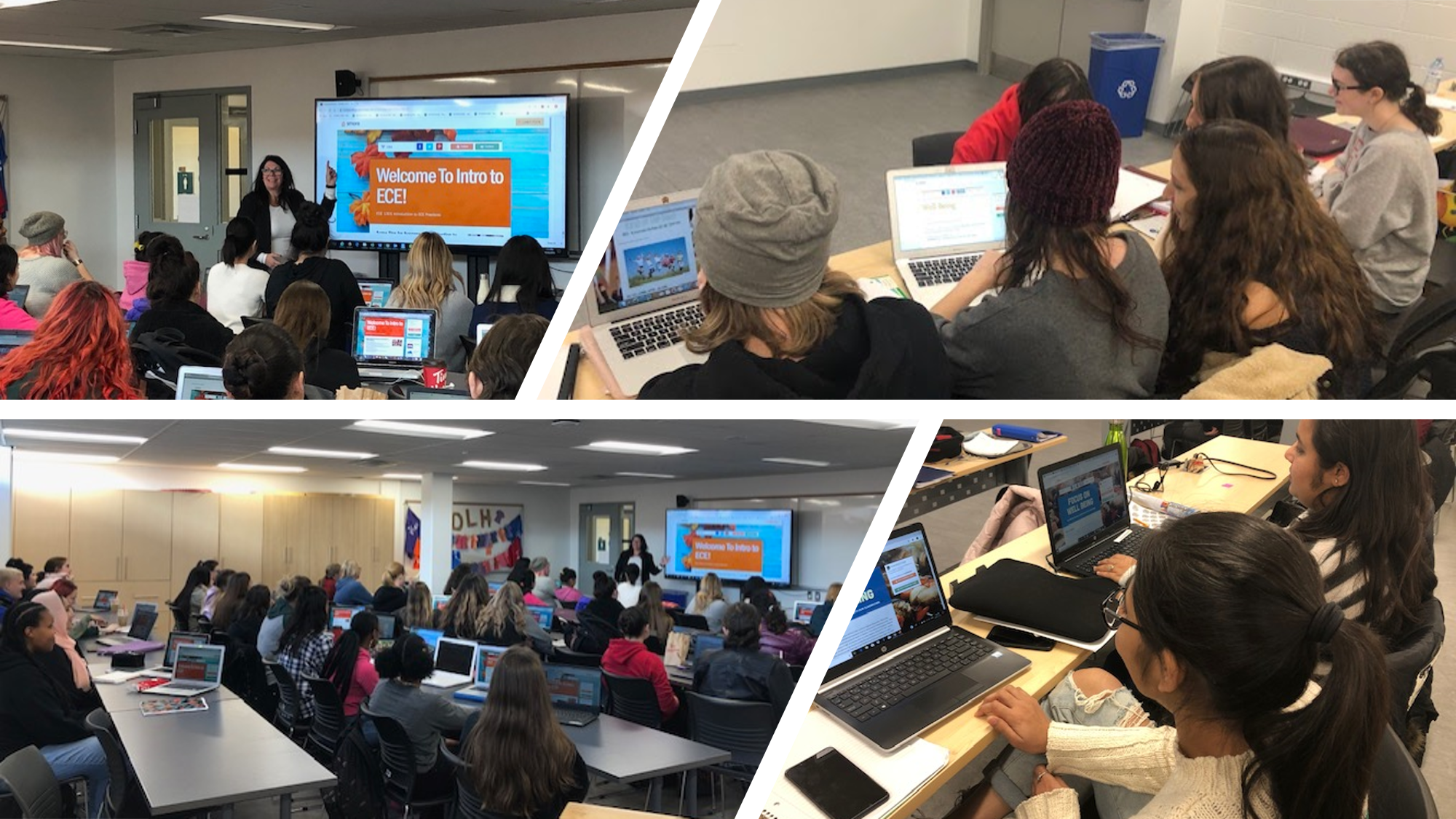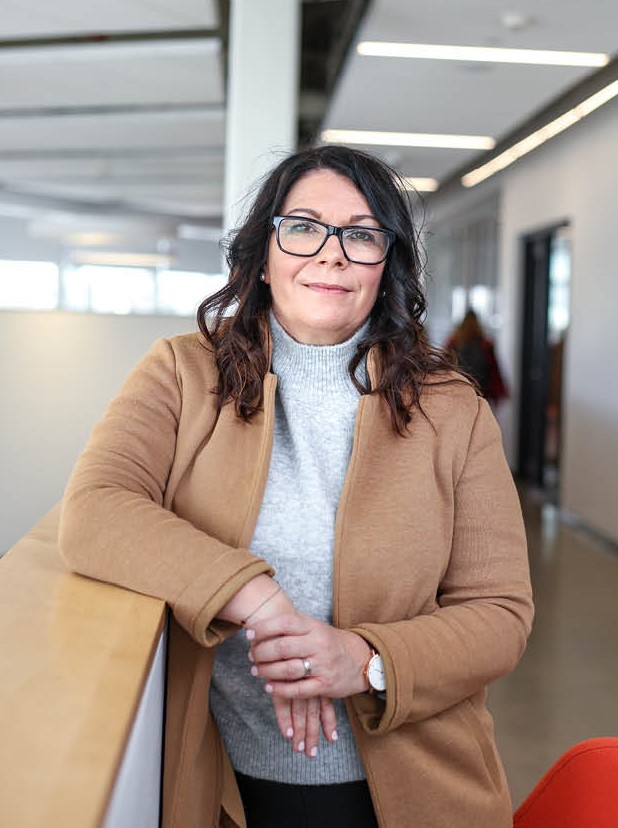32 Using Smore for Assessment Purposes
Corrine McCormick-Brighton
Introduction
Perhaps you are feeling a little hungry with the thought of a sweet treat that is well known to North American campers, but I am afraid this is a digital treat instead! Using Smore is an innovative way for any student or educator to provide information or to demonstrate their knowledge base of a particular topic.
My hope is to encourage learners to make sense of their learning and to think about their thinking (metacognition). I anticipate that through using a digital platform to communicate how they comprehend a pedagogical document (that is relevant for their practice as early educators), that it will aid in their awareness of the material and how they consider applying the document principles in their real-world experiences.
Some Early Childhood Education students are hesitant to incorporate technology into their practice and learning experience. I engage them in class and through our college Learning Management System (LMS) with various digital tools to spark interest and inspire possibilities.
I have been using Smore, a digital newsletter with my students in order to introduce my course in semester one and two of a four-semester program. This provides them with preliminary exposure to the platform so they are familiar with the format and capabilities. I scaffold the learning in the following ways: in the first semester it is demonstrated as an introduction, semester two it is used for an assessment, and semester four it is used as an artefact in a more robust assessment (ePortfolio).
In semester two they are required to select a pedagogical topic from an Ontario Ministry of Education document to review, summarise and reflect upon. They are required to consolidate their learning and create a digital newsletter that demonstrates their topic information. In addition, in semester four they create a digital ePortfolio and the Smore Digital newsletter assessment is often selected as one of their academic artefacts to showcase.
In the field of early learning and care, students will be communicating with families and the newsletter provides a method to share and highlight information that they would like to communicate. It allows students who have limited to no technological, programming, or design experience/abilities to create an impressive communication resource through easy to use templates. This tool is intuitive and is free to access (of course with limitations).
Resources Needed:
- A device, preferably a laptop or tablet.
- Internet connection.
- Smore site.
- Instructions and criteria for Assessment.
- In-class practice time.
Steps for Implementation:
Step 1 Introduce Smore providing an example of how to use Smore.

- Create an account. https://www.smore.com
- Free to try Can create 3 newsletters, then you may want to upgrade for more options. If using for class students can use the free plan (if they are creating 1-3 newsletters).
- Click Start a Newsletter. FAQ and help available (if needed). Video: Getting Started on Smore
- Select template and font (limited with free plan).
- Begin to edit and add content (text, images, links).
- Save and Share.
Step 2 Explain how to get started by having students visit the website and create an account.

Step 3 Allow learners time to explore the templates in class and show them where to find FAQ and support.

Step 4 Link to course learning
Assign them the task of creating a Smore newsletter based on course content that you want them to summarize, reflect on or consolidate.
You can make it a team effort and they can collaborate with peer colleagues (assist with content creation, or review-completed work by sharing links/login).
Case Study:
Smore for assessments allows the learner to access digital information to demonstrate their knowledge in a resourceful way. According to Brevik & Davies (2016), “It appears that the engaging and markedly visual nature of screen-based technologies has the potential to make learning content and student engagement with that content visible and accessible, as well as constituting powerful means for making processes of learning more visible to teachers and learners alike” (p. 16). More than a newsletter, it is an intuitive platform to share digital, print resources, and information. “Smore is a website that lets users design their own online flyers. With a free or paid Smore subscription, you can make flyers that serve as newsletters or promote events, products, or services on social media sites. Flyers can also be printed and distributed.” Retrieved from: https://www.commonsense.org/education/website/smore
I introduce the assessment (semester two) in my course Guidance of the Young Child. I begin by reminding and reviewing how I have introduced the learners previously to Smore; what Smore is, and how they will use it to explore an important topic further. The assessment instructions and criteria are distributed with the Smore link included. Students are provided time in class to begin preliminary work on the Smore (create an account, select a template, and begin to interact with it). The summary, reflection and consolidation of the topic will take more time outside of class to construct, and then they will add this content and any images or links to the Smore. This assessment (link) is submitted through our LMS and I assess and provide feedback through there as well.
Posting videos and resources are recommended for the students to access as well as showing them where to find the Smore site Frequently Asked Questions (FAQ) and support. The students’ comfort level and ability to approach new tools may have an impact on the eagerness of the learners. Some may become frustrated with their novice experience or being unfamiliar with digital tools. Maintaining a positive, supportive approach will go a long way. This particular assessment can be used as an artefact for their ePortfolio assessment in semester four; therefore, I remind the student that they are building upon skills (scaffolding) and are able to use this assessment to contribute toward a larger assessment. Often students will be proud of their accomplishment and appreciate that they can use this work in future.
I believe it is important for students to explore other means of representation to express achieved learning; it fits well with a universal design for learning, and as Thota and Negreiros (2019) posit, “Web-based tools such as wikis, blogs, e-books, online videos and podcasts offer new avenues for multimedia computing and multisensory learning” (p.1). There are many advantages of utilizing digital tools to support learning and extend possibilities. Combining digital media with innovative teaching can help to motivate and inspire learners. Engagement and digital tools can be far-reaching and visible as Brevik & Davies (2016) contend, “they actively engage with the activities, making personal connections between the task and other topics within and beyond the classroom while using digital tools in this engagement” (p. 5). Before moving to a digital assessment it is important to consider potential challenges or barriers that a learner may face and ways to circumvent these.

Top Tips for Success:
- Scaffold learning for new students: use Smore to share information with and to inspire them.
- Encourage them to BYOD (Bring your own device) to access digital tools during lessons (Actively Model and Apply).
- Access and create resources to aid the student with using Smore.
- Provide some in-class time dedicated for exploration of the digital tool (Smore) after explaining the assessment.
- You may consider doing a quick survey, poll or KWL (graphic organizer for students to consider what they already know, what they want to know and what they learned). Types of questions to ask:
- Do you know what this digital tool (Smore) is?
- Have you used this digital tool (Smore) before?
- What are your concerns about using this digital tool (Smore)?
- What are you excited about pertaining to this digital tool (Smore)?
Further Reading:
Brevik, L.M., & C. Davies. (2016). The potential of digital tools for enabling the observation of comprehension in the classroom Nordic Journal of Digital Literacy ,11. Retrieved from https://www.idunn.no/dk/2016/02/the_potential_of_digital_tools_for_enabling_the_observation
Thota, N., & J.G.M. Negreiros. (2019). Introducing Educational Technologies to Teachers: Experience Report. Journal of University Teaching & Learning Practice, 12(1).
Retrieved from https://files-eric-ed-gov.dproxy.library.dc-uoit.ca/fulltext/EJ1054624.pdf
Provini, C. (2020, March 12). Site Review: Smore. Retrieved from Education World: https://www.educationworld.com/a_curr/site-review/smore.shtml
Digital resources
Using SMORE for assessment purposes
- Demo video: 4 basics of smore [3.50 minutes]
- https://www.smore.com/wms34 Smore Tutorial and Sample
Author

Corrine McCormick-Brighton Faculty Member (Professor) in the Early Childhood Education Program, School of Health & Community Services, at Durham College. Employed at Durham College for 27 years, she has a keen interest in innovations related to teaching and learning, in addition to developing authentic assessments. Extensive experience with course development for both face-to-face and online delivery. A co-investigator/researcher, life long learner, and relationship builder that is committed to inspiring and engaging learners. Education: She holds an Early Childhood Education Diploma from Durham College; a Bachelor of Arts Degree from Trent University; a Master of Education (and Digital Technology) from the University of Ontario Institute of Technology (currently OntarioTech University).

